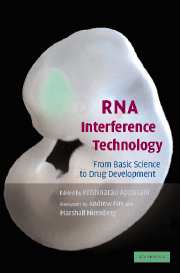Book contents
- Frontmatter
- Contents
- Foreword by Andrew Fire
- Foreword by Marshall Nirenberg
- List of Contributors
- Introduction
- Section one Basic RNAi, siRNA, microRNAs and gene-silencing mechanisms
- Section two Design, synthesis of siRNAs
- Section three Vector development and in vivo, in vitro and in ovo delivery methods
- Section four Gene silencing in model organisms
- Section five Drug target validation
- Section six Therapeutic and drug development
- Section seven High-throughput genome-wide RNAi analysis
- Index
- Plate section
Foreword by Marshall Nirenberg
Published online by Cambridge University Press: 31 July 2009
- Frontmatter
- Contents
- Foreword by Andrew Fire
- Foreword by Marshall Nirenberg
- List of Contributors
- Introduction
- Section one Basic RNAi, siRNA, microRNAs and gene-silencing mechanisms
- Section two Design, synthesis of siRNAs
- Section three Vector development and in vivo, in vitro and in ovo delivery methods
- Section four Gene silencing in model organisms
- Section five Drug target validation
- Section six Therapeutic and drug development
- Section seven High-throughput genome-wide RNAi analysis
- Index
- Plate section
Summary
RNA interference is a powerful tool that has been used to inhibit gene function either by increasing the destruction of mRNA corresponding to the gene, or in some cases, by inhibiting the transcription of the gene or the translation of mRNA to the corresponding protein. Exploring gene function by the classical approach of generating mutants of a gene often is much more laborious and time consuming then silencing gene function by RNAi using double-stranded RNA or double-stranded oligoribonucleotides about twenty two nucleotide residues in length. This book edited by Krishnarao Appasani is a timely and comprehensive compendium of information on RNAi and will be useful to experts on RNAi as well as investigators in many fields of research who may be interested in using RNAi to explore problems they are studying.
The RNAi field is only six years old. Research on RNAi has been expanding at an extraordinarily rapid rate, yet the field is in its infancy. There is great interest in using RNAi as a means of exploring gene function during embryonic development and in the adult in many organisms. Many aspects of RNAi remain to be explored. For example, the reactions and the molecules required for RNAi targeted destruction of mRNA are incompletely known. Similarly, the mechanisms of RNAi targeted modification of DNA, which regulates, transcription of DNA, as well as RNA targeted inhibition of mRNA translation are only partially known. Also, the functions of most micro RNA genes have not yet been explored.
- Type
- Chapter
- Information
- RNA Interference TechnologyFrom Basic Science to Drug Development, pp. xiii - xivPublisher: Cambridge University PressPrint publication year: 2005



